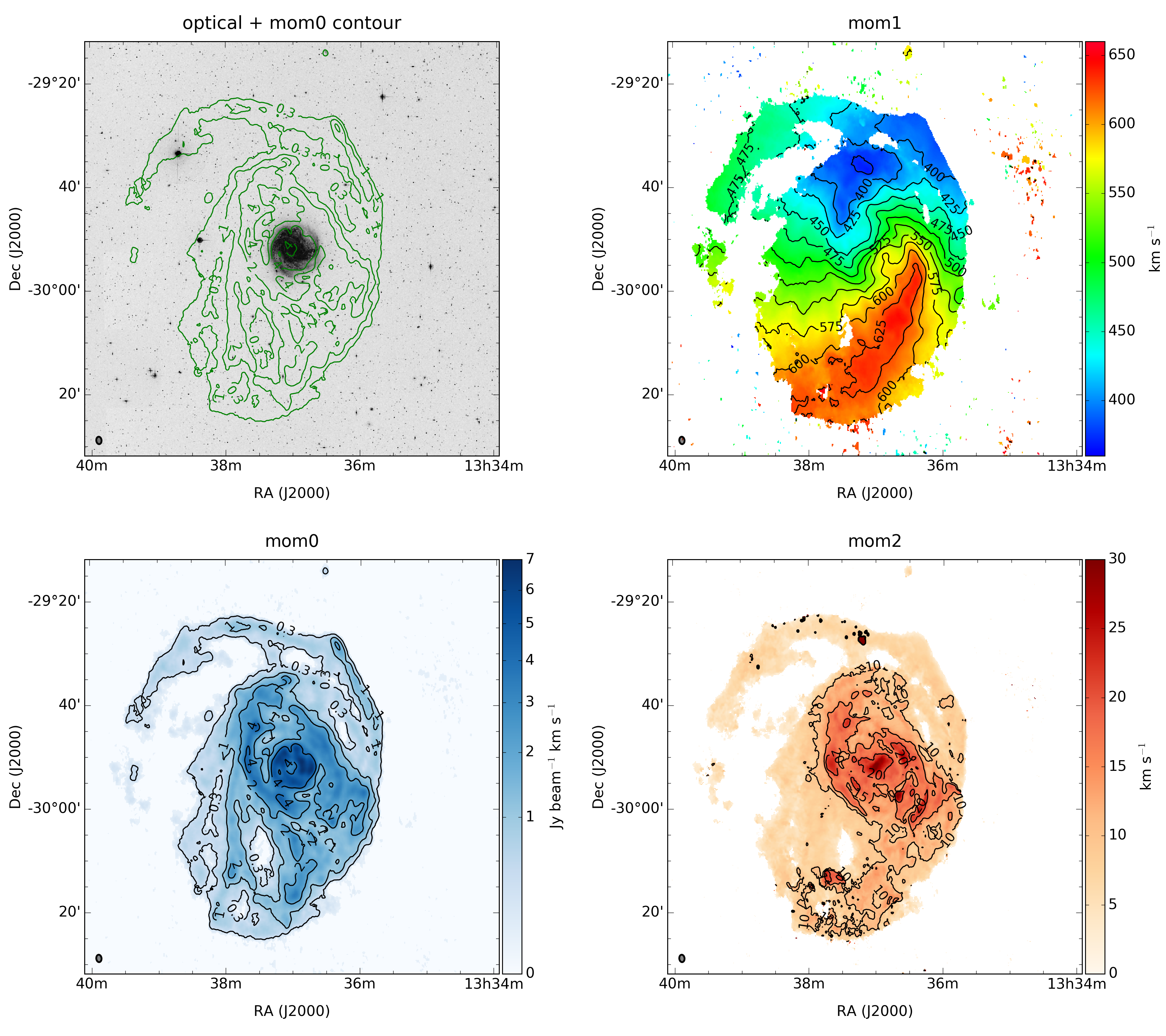Messier 83 (NGC 5236)

M 83 (HIPASS J1337-29)
is a grand-design spiral galaxy with an unusually large HI envelope.
It is located in the Cen A Group and forms the centre of a subgroup consisting
of ~10 known galaxies. A large range of distance estimates exist for M 83, the
majority of which agree to within 10%. We adopt the TRGB distance estimate of
4.92 ± 0.10 Mpc by Jacobs et al. (2009). For comparison, Thim et al.
(2003) estimate 4.5 ± 0.3 Mpc from ground-based cepheid measurements,
while Herrmann et al. (2008) obtain 4.85 ± 0.12 Mpc from the planetary
nebula luminosity function. We calculate a Hubble distance of 4.4 Mpc from
M 83's Local Group velocity of vLG = 332 km/s (Koribalski et al.
2004), assuming Ho = 75 km/s/Mpc. We note that Karachentsev et al.
(2002) also estimate a TRGB distance (4.68 ± 0.46 Mpc) for the stellar
stream located 18.5 arcmin north of M 83, likely an accreted dSph galaxy. This
stream was discovered by Malin & Hadley (1997).
Our ATCA HI mosaic of M 83 and its dwarf companions NGC 5264, IC 4316 and
UGCA 365, is shown in Fig. 9. The integrated HI flux density of M 83 as
measured with the ATCA in the maximum entropy moment map is FHI
= 1384 Jy km/s compared to 1440 Jy km/s in the CLEANed map, both are ~10% lower
than the measured single-dish HI flux density. Walter et al. (2008) recover
only a quarter of the total HI flux density (361 Jy km/s), due to their
single pointing VLA observations and low sensitivity to extended, diffuse HI
emission. The HI distribution of M 83, as mapped with the ATCA, is most
remarkable (Koribalski 2015, 2017; Jarrett et al. 2013). It extends well
beyond the GALEX XUV disc (Thilker et al. 2007), referred to as a
giant 2X−HI disc by Koribalski (2017). No longer does this grand-design
spiral look regular and undisturbed. Our ATCA HI maps show outer disc
streamers, irregular enhancements, an asymmetric tidal arm, diffuse emission,
and a thoroughly twisted velocity field, much in contrast to its regular
appearance in short-exposure optical images. M 83's HI distribution is
enormous, several times larger than its stellar disc. It is also a rather
massive galaxy, mildly interacting with the neighbouring dwarf galaxies. The
effect of this interaction on the dwarfs can of course be rather devastating.
It is indeed quite likely that M 83 has accreted dwarf galaxies in the past.
While the HI distribution of M 83 has previously been studied, we show the
first detailed study of the large-scale emission in M 83 and its surroundings.
Huchtmeier & Bohnenstengel (1981) measured an integrated HI flux density of
about 1632 Jy km/s which agrees well with the HIPASS estimate of 1630 ±
96 Jy km/s for M 83 by Koribalski et al. (2004). At a distance of 4.92 Mpc
this corresponds to an HI mass of 9.3 (±0.5) × 109
M☉. They also derived a total HI extent of 76 arcmin (EW)
× 95 arcmin (NS) for M 83 at a column density of NHI = 6
× 1018 atoms/cm2. For comparison we show the deep
Parkes multibeam HI data of M 83 and its surroundings in Fig.~10. Note that
the gridded Parkes beam is 15.5 arcmin, and 1 Jy/beam km/s corresponds to
~1.4 × 1018 atoms/cm2. We measure a very similar
HI extent of roughly 80 arcmin × 88 arcmin (±4 arcmin), i.e.
roughly 100 kpc. The HI distribution is clearly asymmetric as already noted
by Huchtmeier & Bohnenstengel, the reason for which becomes immediately obvious
in our high-resolution ATCA HI images. The latter reveal an extended arm
emerging from the western part of M 83 and curving 180 degr around to the east.
The overall impression of M 83 in neutral hydrogen is that of a distorted
one-armed spiral, indicating that it may have interacted or merged with
another, smaller galaxy. While the velocity field in this extended arm appears
to follow the general pattern of rotation, the gas distribution shows numerous
irregularities, clumps and bifurcations. The 20 arcmin long ridge in the
northwest ends in a noticable HI clump and marks a kink in the outer arm. The
HI velocity field of M 83 highlights the warped nature of the disc. Using 3D
FAT Kamphuis et al. (2015) obtained an HI rotation curve indicating
vrot = 157.0 km/s at Rmax = 50.0 kpc (for i = 40.3 degr
and PA = 226.9 degr) and Mdyn = 2.8 × 1011
M☉.
The eastern-most HI emission of M 83 which forms part of its peculiar, outer
arm lies at α,δ(J2000) = 13:39:40, -29:51:45 (vhel =
536 km/s), i.e. ~34.5 arcmin (45 kpc) away from the centre of M 83. We note
that the dwarf irregular galaxy NGC 5264 (HIPASS J1341-29; vsys =
478 km/s) lies at a projected distance of only 25.5 arcmin (33 kpc) from the
eastern HI edge of M 83. Given that the independently measured distances to
M 83 and NGC 5264 are very similar both galaxies are likely to be interacting.
Reference:
Koribalski et al. 2018
* LVHIS database
* LVHIS homepage
* next